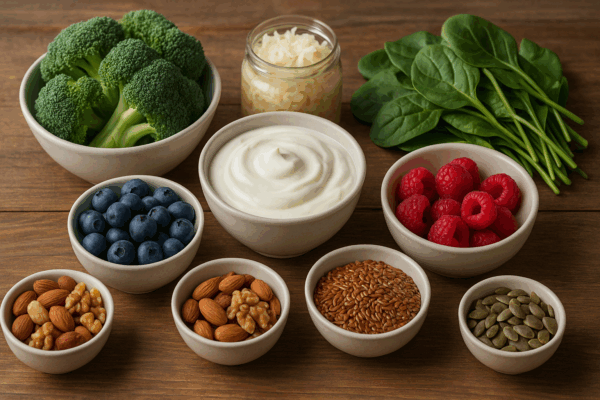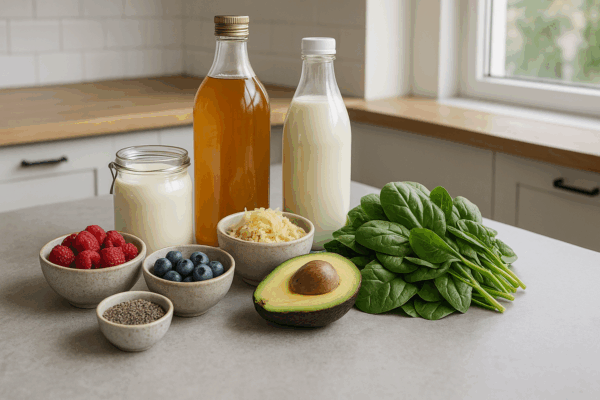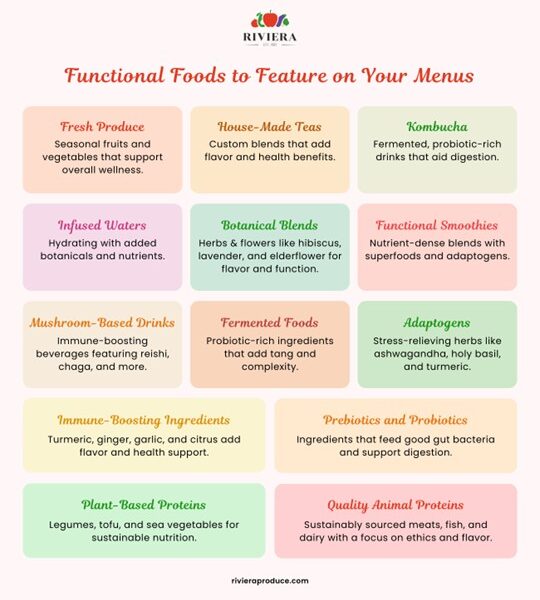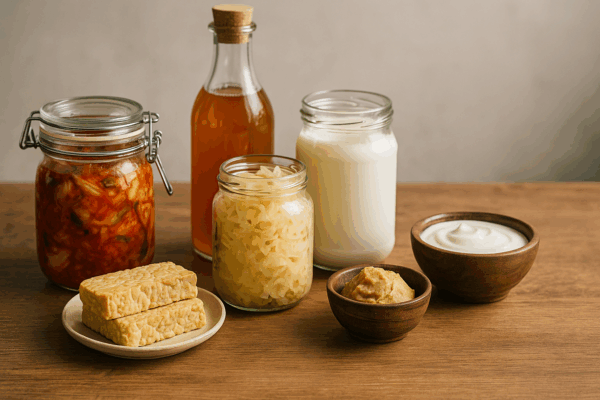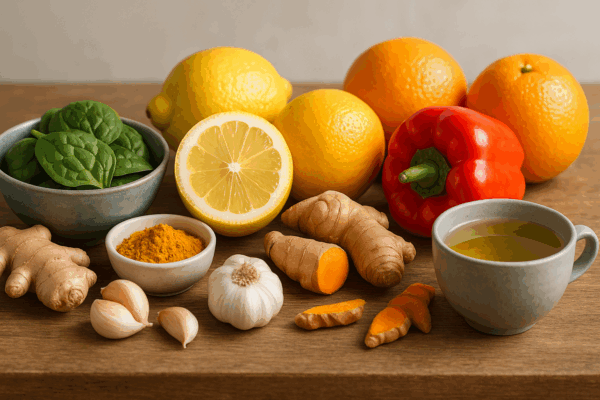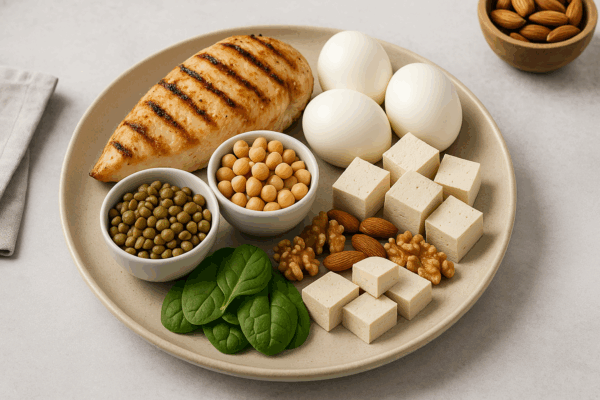Functional Foods in NYC: Trends, Ingredients & Supply
The food landscape is evolving, with healthy foods leading the charge. One category, in particular, is making waves as a top trend for consumers in 2025: functional foods.
Diners now focus more on health benefits in their food choices. They look for gut-supporting ingredients, brain-boosting superfoods, and wellness drinks, all types of functional food designed to support their well-being.
In New York, consumer tastes influence kitchen menus. Functional foods are not just a trend; they are becoming a permanent part of our meals. So, how can restaurants in New York tap into this shift and make the most of functional foods?
In this article, we will examine the top functional food trends for NYC menus in 2025 and share tips for chefs on how to innovate and meet diners’ wellness goals.
What Are Functional Foods and Why Are They Trending?
These days, the term “functional food” is everywhere. From grocery aisles to restaurant menus, it’s one of the top 2025 food trends, and it’s not going anywhere. That’s because the demand for functional food is growing, not just in health stores but also in commercial kitchens.
Functional foods are more than just fuel. Packed with key vitamins and minerals, they help boost immunity, support digestion, and sharpen mental focus, all while adding value to your menu.
So, what qualifies as a functional food? You can find a wide range of foods, including fruits, vegetables, legumes, quality fish, and dairy. Also, people consume fermented foods, adaptogens, and fortified products. The list continues!
Functional foods give NYC chefs many choices to try new things while helping their guests’ health. Many chefs see functional foods as essential in their kitchens. Now, they focus on the benefits of these foods, not just their taste.
Here’s why functional foods are getting so much attention right now:
- Health-Driven Dining:
The pandemic marked a significant shift in consumer interest in health and well-being. Customers are seeking foods that align with wellness goals like immunity, gut health, and stress reduction.
Millennials began to pick healthier options. Now, Gen Z is leading in functional food trends. This shows that these health-boosting meals are here to stay.
- Rising Food Costs:
With food prices up across the board, customers are expecting more value from each dish. Restaurants are also looking for ingredients that go further. Functional foods offer dual benefits, enhancing nutritional value and supporting the rationale for increased menu pricing.
- Food as Medicine:
Growing interest exists in meals that do more than taste good. This is increasing demand from aware consumers for ingredients that focus on prevention. These include adaptogens, probiotics, and anti-inflammatory herbs. These ingredients help guests feel they are making a smart nutritional choice when ordering.
- Sustainability and Transparency:
Today’s customers want to know what they’re eating and where it comes from. Fresh foods, clean labels, organic ingredients, and clear sourcing are now standard expectations. This is especially true for health-focused menus.
The global market for functional food is growing. Analysts expect the increase from USD 398.81 billion in 2025 to USD 793.60 billion by 2032. In the United States alone, it could reach USD 117.22 billion. Check out the 2025 market growth forecast.
Top Functional Foods to Stock Up on in 2025
Riviera Produce sells many popular functional foods in bulk. Many of these foods are seasonal, locally sourced, or delivered directly from the farm.
Here is a list of healthy food options. These foods are full of nutrients and great for NYC menus. These options are ideal for chefs focused on menu development that meets today’s health-conscious dining trends.
- Kale: loaded with vitamins A, C, and K. It’s excellent for salads, soups, or chips and pairs well with fresh herbs to elevate flavor and nutrition.
- Blueberries: Are rich in antioxidants. Perfect in sauces, smoothies, or baked goods.
- Turmeric: Anti-inflammatory and warming. Use in teas, dressings, and marinades.
- Yogurt: Probiotic-rich for gut health. Use in dips, sauces, or breakfast bowls.
- Almond Milk: Dairy-free and versatile. Ideal for lattes, smoothies, and sauces.
- Ginger: Aids digestion and immunity. Works in stir-fries, teas, and desserts.
- Avocados offer healthy fats and fiber. They are a fan favorite in everything from brunch toast to creamy sauces.
- Lentils: Protein-packed and filling. Perfect for soups, salads, stews, and grain bowls.
All these ingredients are considered premium functional food staples for wellness-forward kitchens.
Want to add these powerhouse ingredients to your kitchen?
Riviera Produce offers fresh, wholesale produce and functional foods sourced with care, with flexible bulk ordering options ready to be delivered straight to your NYC kitchen, perfect for serving today’s health-conscious consumers.
Seasonal Superfoods for Spring and Summer Menus
One of the best ways to make the most out of functional foods is to catch these superfoods at their seasonal peak, when nutrients and flavor are highest:
- Asparagus: Rich in prebiotics, fiber, and folate.
- Spinach: High in iron and vitamin-dense.
- Strawberries and Blueberries: Rich in antioxidants and vitamins
- Zucchini: Low-calorie and high in potassium.
- Mint & Basil: Flavorful, anti-inflammatory herbs
- Watercress: Often overlooked, but it’s packed with nutrients.
By highlighting functional food in new and exciting formats, Manhattan restaurants can stay both relevant and profitable.
Emerging Functional Food Trends in 2025
The food industry has entered a new era. Health and wellness matter more than ever, and diners want to feel good about their food choices.
A 2025 industry report from Restaurant 265 reveals a significant trend: an increasing demand for healthier and specialty menu items. Today’s health-focused menus go beyond adding kale or calling something a “superfood.” Guests want value, excitement, and real quality, pushing restaurants to get creative with functional ingredients.
Thinking about updating your menu with trending ingredients? Explore Riviera’s chef-approved produce, dairy-free staples, and adaptogens. We deliver fresh, clean-label ingredients daily across NYC.
Here are the leading functional food trends popping up across restaurant kitchens this year:
Functional Beverages Are Taking Over Menus
Functional beverages are one of the fastest-growing subcategories of functional food, especially in health-focused dining.
In 2025, plain coffee and soda will not cut it anymore. As consumer interest in functional foods and beverages continues to rise, more restaurants are joining the wellness drink trend.
House-made teas, kombucha, infused waters, and botanical blends are gaining popularity on bar menus. Functional smoothies and mushroom-based drinks are also trendy choices. As demand grows for low- and no-alcohol drinks, these options provide a tasty and healthier choice.
Chef’s Tip: Make functional drinks like hibiscus tea or citrus-kombucha spritzers in batches while prep. This not only saves time during service, but it also gives FOH staff more wellness-forward options to upsell with confidence.
1. Fermented Foods Bring Unexpected Flavors
Kefir, kimchi, miso, and other fermented ingredients are trending as top picks in 2025’s consumer preferences. These bold, tangy ingredients offer depth of flavor while supporting gut health with live probiotics.
The possibilities go way beyond the pickle plate, from kimchi aioli to miso butter and kefir-based dressing. Chefs can easily make fermented food products at home, allowing them to get creative with unique ingredients and flavor combinations.
Need help sourcing fermented ingredients like kimchi, miso, or kefir?
We work with top producers and local farms to provide high-quality fermented items that your diners in New York City will enjoy.
Chef’s Tip: Try introducing a rotating house-fermented special, like a miso marinade, hot honey, or house-made pickled slaw. It adds a unique, small-batch element that diners love while letting you control cost and consistency.
2. Adaptogens and Botanicals Are Going Mainstream
Once reserved for health stores and smoothie bars, adaptogens are now becoming common in restaurant kitchens. Ingredients like ashwagandha, holy basil, turmeric, and ginseng are popular. They help relieve stress, boost immunity, and support brain health.
But it’s not just about roots and powders. Botanical ingredients like hibiscus, elderflower, chamomile, and lavender offer natural antioxidants and floral notes, boosting both flavor and nutritional function.
You’ll find them in teas, syrups, dressings, or as fragrant garnishes for desserts and cocktails. They provide anti-inflammatory benefits, help digestion, and offer natural antioxidants. Plus, they add unique floral notes.
For a refreshing and wellness-focused treat, try a hibiscus spritzer or a lavender dessert. These quiet standouts will keep guests coming back.
Chef’s Tip: Start small with botanical syrups or garnishes in your drinks and desserts. A chamomile-honey glaze or lavender sugar rim can elevate an otherwise simple dish without needing a full recipe overhaul.
3.Immune-Boosting Flavors That Pull Double Duty
In a post-pandemic world, diners are paying more attention to how food supports their health, especially immunity. Turmeric, garlic, ginger, and citrus are just a few of the top immune-boosting ingredients chefs are incorporating into wellness-focused menus, many of which are recognized by the Food and Drug Administration for their potential health benefits.
Beyond their health benefits, these ingredients offer both immune support and culinary versatility. Use immune-supportive ingredients like turmeric honey glaze, lemon-ginger dressing, or roasted garlic aioli. They add health benefits with minimal effort and won’t change your menu in a significant way.
Chef’s Tip: Use citrus peels and ginger scraps to create house infusions or syrups for bar use or dressings. It reduces waste and spreads immune-boosting benefits across different menu areas.
4. High-Quality Animal Proteins: Sustainable and Responsible Choices
More consumers want ethically sourced meat, fish, and dairy that align with sustainability values. This includes sourcing from local farms and tri-state area suppliers that prioritize animal welfare, sustainable fishing practices, and regenerative agriculture.
Chefs are making dishes that highlight these top-quality proteins. They also share details about where the proteins come from and how manufacturers make them.
Chef’s Tip: Highlight the farm or fishery on your menu or server script. A simple note like “line-caught off Montauk” or “pastured beef from Upstate NY” boosts value. It also tells guests where their food comes from, reinforcing transparent restaurant sourcing practices.
Looking for sustainably sourced meats and dairy? Riviera offers premium animal proteins from local farms that align with your kitchen’s values
- Prebiotics and Probiotics for Gut Health
This is one of the most well-researched areas of functional food, combining microbiome science and taste.
Diners care more than ever about gut health, but it’s not about probiotics anymore. Prebiotic ingredients such as garlic, onions, leeks, and asparagus help good gut bacteria. They improve digestion and add delicious flavors. Pair them with fermented foods for a powerful punch of flavor and function.
Chef’s Tip: Create healthy pairings by combining prebiotics and probiotics. For example, you can serve roasted asparagus with a dollop of kefir cream, or top a leek tart with fermented radishes — creative combinations that bring wellness into the fine dining experience.
- Plant-Based Proteins and Dairy-Free Staples Keep Growing
Demand for vegan, plant-based, and dairy-free options isn’t slowing down. Lentils, chickpeas, tofu, and beans are go-to vegan-friendly sources, while almond, oat, and soy milk are now menu mainstays, and ingredients like flaxseed and chia are being added for their omega-3 fatty acids benefits.
The focus is on whole ingredients that offer clean nutrition. This keeps menus inclusive. They provide good nutrition and tasty meals.
Some restaurants are exploring sea vegetables like water lentils and spirulina. These options are nutrient-dense and sustainable, excellent examples of sustainable products that make great additions to plant-based menus.
Chef’s Tip: Roast or char plant-based proteins to build depth and texture. A nice sear on tofu or crispy lentils creates the contrast that diners want from meat dishes, but it still keeps the flavor.
How Functional Foods Help NYC Restaurants Stay Ahead.
How Functional Foods Help NYC Restaurants Stay Ahead with Functional Food Innovation
New York chefs and operators consider functional foods a smart choice. They help meet changing consumer expectations, support kitchen efficiency, and improve menu value perception.
At the same time, they keep kitchens efficient and cost-effective. Here’s why they deserve a special spot on your menus:
- Adding Nutritional Value Without Extra Complexity
Lentils, ginger, and leafy greens are great functional ingredients. They offer many nutritional benefits and are easy to prepare. Chefs can enhance menu appeal and health benefits with items already in their pantry.
- Cross-Functional Ingredients Streamline Menus
Most functional foods are naturally versatile. This flexibility makes inventory efficient. It also lets you be creative without overloading your shopping and prep lists.
- Appeals to Health-Conscious Diners
Guests are reading menus closely, especially in New York, where wellness-driven dining is rising. Showcasing functional food tells health-conscious diners, ‘We see you.’
- Supports Margins and Increases Value Perception
With food costs rising, functional ingredients offer a smart way to add depth, texture, and nutrition without overspending. Guests also perceive health-forward, house-made items as higher value, so you can justify a stronger price point with less cost.
Functional foods let you share the story of your ingredients. This way, guests enjoy a dining experience that feels genuine and meaningful.
Where to Buy Functional Foods in Bulk in NYC
Looking for a reliable bulk supplier of functional ingredients?
As a trusted wholesale food supplier in Manhattan, Riviera Produce helps NYC restaurants, cafes, juice bars, and kitchens find top-quality, clean-label ingredients. These ingredients boost both flavor and function.
Supported by a reliable local food distribution network to ensure freshness and fast delivery across NYC. We partner with trusted local and regional farms to bring you:
- Fresh seasonal produce
- Prebiotic and probiotic-rich items
- Superfruits and nutrient-dense vegetables
- Specialty herbs and adaptogenic ingredients
- Quality animal protein
- Fermented foods
Riviera helps you keep your kitchen stocked with seasonal produce and special wellness items, making it easy to stay ahead with your menu. Our flexible ordering options, quick turnaround, and custom case packs mean you get what you need when you need it.
With Riviera, NYC restaurants can ensure a steady supply of premium functional food all year round.
Frequently Asked Questions
Functional foods offer benefits beyond basic nutrition, like improving gut health and memory or boosting immunity. Use them in smoothies, entrees, main courses, dressings, or desserts.
Riviera Produce offers bulk seasonal and specialty functional foods for restaurants and food businesses across NYC.
Blueberries, kale, spinach, avocados, and turmeric are all highly functional and versatile.
Yes. Riviera supplies milk alternatives in restaurant-friendly quantities.
Wellness drinks, fermented foods, immunity-boosting ingredients, and quality protein are all in demand.
They contain nutrients like antioxidants, probiotics, and anti-inflammatory compounds that help the body stay balanced, especially under stress.
